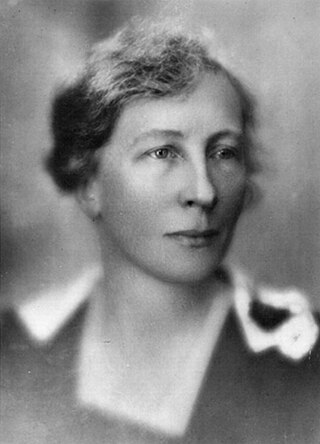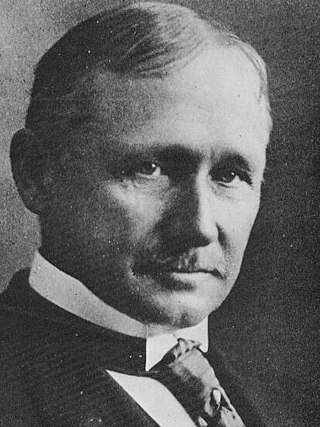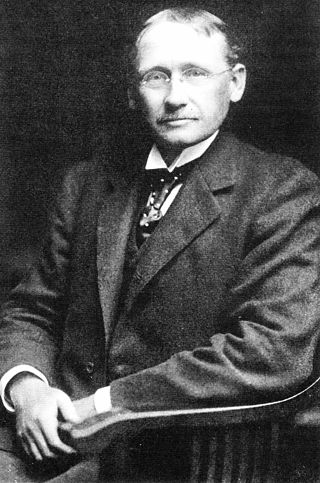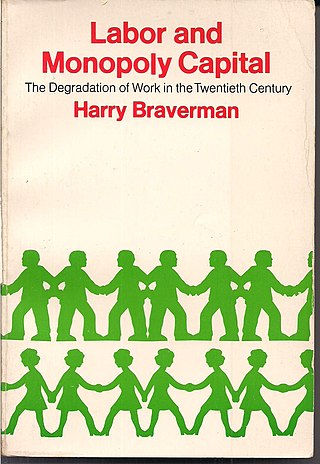A time and motion study (or time-motion study) is a business efficiency technique combining the Time Study work of Frederick Winslow Taylor with the Motion Study work of Frank and Lillian Gilbreth (the same couple as is best known through the biographical 1950 film and book Cheaper by the Dozen ). It is a major part of scientific management (Taylorism). After its first introduction, time study developed in the direction of establishing standard times, while motion study evolved into a technique for improving work methods. The two techniques became integrated and refined into a widely accepted method applicable to the improvement and upgrading of work systems. This integrated approach to work system improvement is known as methods engineering [1] and it is applied today to industrial as well as service organizations, including banks, schools and hospitals. [2]
Time study is a direct and continuous observation of a task, using a timekeeping device (e.g., decimal minute stopwatch, computer-assisted electronic stopwatch, and videotape camera) to record the time taken to accomplish a task [3] and it is often used if at least one of the following applies: [4]
The Industrial Engineering Terminology Standard, defines time study as "a work measurement technique consisting of careful time measurement of the task with a time measuring instrument, adjusted for any observed variance from normal effort or pace and to allow adequate time for such items as foreign elements, unavoidable or machine delays, rest to overcome fatigue, and personal needs." [5]
The systems of time and motion studies are frequently assumed to be interchangeable terms that are descriptive of equivalent theories. However, the underlying principles and the rationale for the establishment of each respective method are dissimilar, despite originating within the same school of thought.
The application of science to business problems and the use of time-study methods in standard setting and the planning of work were pioneered by Frederick Winslow Taylor. [6] Taylor liaised with factory managers and from the success of these discussions wrote several papers proposing the use of wage-contingent performance standards based on scientific time study. [7] At its most basic level time studies involved breaking down each job into component parts, timing each part and rearranging the parts into the most efficient method of working. [8] By counting and calculating, Taylor wanted to transform management, which was essentially an oral tradition, into a set of calculated and written techniques. [9] [10]
Taylor and his colleagues placed emphasis on the content of a fair day's work and sought to maximize productivity irrespective of the physiological cost to the worker. [11] For example, Taylor thought unproductive time usage (soldiering) to be the deliberate attempt of workers to promote their best interests and to keep employers ignorant of how fast work could be carried out. [12] This instrumental view of human behavior by Taylor prepared the path for human relations to supersede scientific management in terms of literary success and managerial application.
Following is the procedure developed by Mikell Groover for a direct time study: [13]
According to good practice guidelines for production studies [14] a comprehensive time study consists of:
Easy analysis of working areas
The collection of time data can be done in several ways, depending on study goal and environmental conditions. Time and motion data can be captured with a common stopwatch, a handheld computer or a video recorder. There are a number of dedicated software packages used to turn a palmtop or a handheld PC into a time study device. As an alternative, time and motion data can be collected automatically from the memory of computer-control machines (i.e. automated time studies).
In response to Taylor's time studies and view of human nature, many strong criticisms and reactions were recorded. Unions, for example, regarded time study as a disguised tool of management designed to standardize and intensify the pace of production. Similarly, individuals such as Gilbreth (1909), Cadbury [15] and Marshall [16] heavily criticized Taylor and pervaded his work with subjectivity. For example, Cadbury [17] in reply to Thompson [18] stated that under scientific management employee skills and initiatives are passed from the individual to management, [19] a view reiterated by Nyland. [20] In addition, Taylor's critics condemned the lack of scientific substance in his time studies, [21] in the sense that they relied heavily on individual interpretations of what workers actually do. [22] However, the value in rationalizing production is indisputable and supported by academics such as Gantt, Ford and Munsterberg, and Taylor society members Mr C.G. Renold, Mr W.H. Jackson and Mr C.B. Thompson. [23] Proper time studies are based on repeated observation, so that motions performed on the same part differently by one or many workers can be recorded, to determine those values that are truly repetitive and measurable.
In contrast to, and motivated by, Taylor's time study methods, the Gilbreths proposed a technical language, allowing for the analysis of the labor process in a scientific context. [24] The Gilbreths made use of scientific insights to develop a study method based upon the analysis of "work motions", consisting in part of filming the details of a worker's activities and their body posture while recording the time. [25] The films served two main purposes. One was the visual record of how work had been done, emphasizing areas for improvement. Secondly, the films also served the purpose of training workers about the best way to perform their work. [26] This method allowed the Gilbreths to build on the best elements of these workflows and to create a standardized best practice. [27]
Although for Taylor, motion studies remained subordinate to time studies, the attention he paid to the motion study technique demonstrated the seriousness with which he considered the Gilbreths' method. The split with Taylor in 1914, on the basis of attitudes to workers, meant the Gilbreths had to argue contrary to the trade unionists, government commissions and Robert F. Hoxie [28] who believed scientific management was unstoppable. [29] The Gilbreths were charged with the task of proving that motion study particularly, and scientific management generally, increased industrial output in ways which improved and did not detract from workers' mental and physical strength. This was no simple task given the propaganda fuelling the Hoxie report and the consequent union opposition to scientific management. In addition, the Gilbreths credibility and academic success continued to be hampered by Taylor who held the view that motion studies were nothing more than a continuation of his work.
Both Taylor and the Gilbreths continue to be criticized for their respective work, but it should be remembered that they were writing at a time of industrial reorganization and the emergence of large, complex organizations with new forms of technology. Furthermore, to equate scientific management merely with time and motion study and consequently labor control not only misconceives the scope of scientific management but also misinterprets Taylor's incentives for proposing a different style of managerial thought. [30]
A health care time and motion study is used to research and track the efficiency and quality of health care workers. [31] In the case of nurses, numerous programs have been initiated to increase the percent of a shift nurses spend providing direct care to patients. Prior to interventions nurses were found to spend ~20% of their time doing direct care. After focused intervention, some hospitals doubled that number, with some even exceeding 70% of shift time with patients, resulting in reduced errors, codes, and falls. [32] [33]

Lillian Evelyn Gilbreth was an American psychologist, industrial engineer, consultant, and educator who was an early pioneer in applying psychology to time-and-motion studies. She was described in the 1940s as "a genius in the art of living." Gilbreth, one of the first female engineers to earn a Ph.D., is considered to be the first industrial/organizational psychologist. She and her husband, Frank Bunker Gilbreth, were efficiency experts who contributed to the study of industrial engineering, especially in the areas of motion study and human factors. Cheaper by the Dozen (1948) and Belles on Their Toes (1950), written by two of their children tell the story of their family life and describe how time-and-motion studies were applied to the organization and daily activities of their large family. Both books were later made into feature films.

Frederick Winslow Taylor was an American mechanical engineer. He was widely known for his methods to improve industrial efficiency. He was one of the first management consultants. In 1909, Taylor summed up his efficiency techniques in his book The Principles of Scientific Management which, in 2001, Fellows of the Academy of Management voted the most influential management book of the twentieth century. His pioneering work in applying engineering principles to the work done on the factory floor was instrumental in the creation and development of the branch of engineering that is now known as industrial engineering. Taylor made his name, and was most proud of his work, in scientific management; however, he made his fortune patenting steel-process improvements. As a result, scientific management is sometimes referred to as Taylorism.

Scientific management is a theory of management that analyzes and synthesizes workflows. Its main objective is improving economic efficiency, especially labor productivity. It was one of the earliest attempts to apply science to the engineering of processes to management. Scientific management is sometimes known as Taylorism after its pioneer, Frederick Winslow Taylor.
Therbligs are elemental motions used in the study of workplace motion economy. A workplace task is analyzed by recording each of the therblig units for a process, with the results used for optimization of manual labour by eliminating unneeded movements. Eighteen therbligs have been defined.

Frank Bunker Gilbreth was an American engineer, consultant, and author known as an early advocate of scientific management and a pioneer of time and motion study, and is perhaps best known as the father and central figure of Cheaper by the Dozen.

Operations management is concerned with designing and controlling the production of goods and services, ensuring that businesses are efficient in using resources to meet customer requirements.
Business process mapping refers to activities involved in defining what a business entity does, who is responsible, to what standard a business process should be completed, and how the success of a business process can be determined.
In industrial engineering, the standard time is the time required by an average skilled operator, working at a normal pace, to perform a specified task using a prescribed method. It includes appropriate allowances to allow the person to recover from fatigue and, where necessary, an additional allowance to cover contingent elements which may occur but have not been observed.
Engineering psychology, also known as Human Factors Engineering, is the science of human behavior and capability, applied to the design and operation of systems and technology. As an applied field of psychology and an interdisciplinary part of ergonomics, it aims to improve the relationships between people and machines by redesigning equipment, interactions, or the environment in which they take place. The work of an engineering psychologist is often described as making the relationship more "user-friendly."
The Psychology of Management: The Function of the Mind in Determining, Teaching, and Installing Methods of Least Waste is a book written by Lillian Gilbreth which investigates the psychological aspects of scientific management, incorporating concepts of human relations and worker individuality into management principles. Published in 1914, it is a major early work in the field of industrial psychology and scientific management. A contemporary book review reflects early resistance to scientific management, stating the book "does not answer the really important questions about the effect of standardized work upon the worker".

Industrial engineering is an engineering profession that is concerned with the optimization of complex processes, systems, or organizations by developing, improving and implementing integrated systems of people, money, knowledge, information and equipment. Industrial engineering is central to manufacturing operations.

Labor and Monopoly Capital: The Degradation of Work in the Twentieth Century is a book about the economics and sociology of work under monopoly capitalism by the political economist Harry Braverman. Building on Monopoly Capital by Paul A. Baran and Paul Sweezy, it was first published in 1974 by Monthly Review Press.
Edward Cadbury was a British chairman of Cadbury Brothers, business theorist, and philanthropist, known for his pioneering works on management and organisations.
Allan Herbert Mogensen, known as Mogy, was an American industrial engineer, and industry consultant, and an authority in the field of work simplification and office management. He is noted for popularizing flowcharts in the 1930s, and is remembered as "father of work simplification"
Gilbreth, Inc. was the early management consulting and industrial engineering firm of Frank Bunker Gilbreth and his wife Lillian Moller Gilbreth. It was founded as Frank B. Gilbreth, Inc., consulting engineers, in 1911. Lillian renamed it Gilbreth, Inc. after Frank's death in 1924.

The Taylor Society was an American society for the discussion and promotion of scientific management, named after Frederick Winslow Taylor.
Charles D. Wrege was an American management historian, and Professor at Rutgers University. He is known for his contributions to management history, especially his critical work on Frederick W. Taylor and scientific management.

Harold Bright Maynard was an American industrial engineer, consulting engineer at the Methods Engineering Council, and management author. He is known as the "Broadway counsel for industries, railroads, state governments" and as recipient of the Henry Laurence Gantt Medal in 1964.
The Gilbreth Medal is named after Frank Bunker Gilbreth Sr. and Lillian Gilbreth and is presented in recognition of excellence in the field of motion, skill, and fatigue study. Originally awarded in 1931 by the Society of Industrial Engineers, the award continues to be presented following the organization's merger in 1936 with The Taylor Society under the new organization, The Society for Advancement of Management.
Ralph Mosser Barnes was an American industrial engineer and Professor of Industrial Engineering at the University of Iowa, and the University of California, Los Angeles. He is known as author of the 1937 "Motion and Time Study," which would become standard work for industrial engineers for generations, and as recipient of the 1941 Gilbreth Medal.